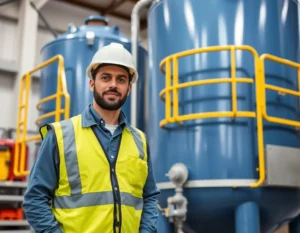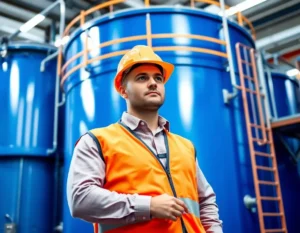In the history of humanity, one of the great milestones was the settlement of communities. Sedentary lifestyle, that is, settling in a fixed place, was possible thanks to the ability to store resources, especially food. As a species, we haven't changed much: we continue to rely on resource storage to ensure not only our survival, but also our well-being. In today's societies, the manufacture of stainless steel tanks is essential for this purpose.
Next, we will explain to you what the manufacturing of stainless steel tanks. In addition, we will detail the advantages that stainless steel offers for the manufacture of tanks, the various uses of these tanks and the characteristics that make them stand out.
What are stainless steel tanks?
Before telling you what the stainless steel tank manufacturing process consists of, it is necessary to know what a stainless steel tank is. These tanks are deposits or containers intended for the storage of liquid, solid or gaseous elements that could not be left exposed to the air or to inclement weather.
Stainless steel tanks are deposits designed, manufactured and installed taking into account the storage requirements that are initially planned. Thus, in the case of looking for a tank for fuel storage, the characteristics that this tank must have are outlined, such as the capacity, the type of material, the shape and even the spatial arrangement of its installation (whether it will be above ground or underground). .
These deposits are widely recognized and used in the most varied industries. From the industrial and productive sector itself, such as the pharmaceutical, fuel, food and agricultural sectors. They are also used with notable success in the liquor industry.
At Perez Precision Works, We have the experience to offer you the manufacture of stainless steel tanks of optimal quality, fully guaranteed.
Advantages of stainless steel
The benefits of stainless steel are evident in any type of element made with this alloy. Below, we detail their main advantages. The exceptional properties of this metal are due to a passive oxidation layer or film that forms on stainless steel in the presence of oxygen, a phenomenon known as "passivation." This is possible thanks to the addition of a small percentage of chromium (between 10.5% and 12%, depending on the type of stainless steel).
The manufacture of stainless steel tanks ensures that the final product has a series of advantageous characteristics in the following aspects:
- Moisture corrosion resistant: Ideal for environments where exposure to water and humidity is constant.
- Resistant to wear and tear from corrosive substances: Perfect for storing chemicals and other materials that can be aggressive.
- Resistant to extreme temperatures: Withstands both high and low temperatures, maintaining its structural integrity.
- Shock and scratch resistant: Its robustness makes it suitable for industrial environments where it may be subject to physical impacts.
How is the manufacture of stainless steel tanks?
To understand the stainless steel tank manufacturing process, it is essential to recognize that each tank is designed to meet specific needs. If large quantities of fuel need to be stored, for example, the tank must have adequate capacity to meet demand and must include additional systems to ensure safe storage.
The first step in manufacturing stainless steel tanks is a meeting with the client or project manager. In this phase, the purpose of the tank, its layout and the installation location are defined. If the characteristics of the tank require it, it may be more convenient to manufacture it directly at the installation site to avoid costs and efforts in transportation.
During this initial phase of stainless steel tank manufacturing, aspects such as tank dimensions, secondary or auxiliary systems, installation criteria and safety measures must be clarified. Once a consensus is reached on materials, design, installation and characteristics of the tank, manufacturing can begin.
The stainless steel tank manufacturing process includes the following steps:
- Material selection: The most appropriate type of stainless steel is chosen, considering its composition and caliber, for the type of substance to be stored.
- cutting and folding: Using specialized machinery, stainless steel sheets are cut and folded to exact measurements. Precision in this stainless steel tank manufacturing process is essential to minimize the space that must be filled with welding, thus reducing the risk of cracks or fissures.
- Welding: The parts are assembled by welding, using the most appropriate type of welding to ensure the structural integrity of the tank.
- Cleaning: Once the deposit is formed, it is cleaned to remove grease, dust, dirt and welding residue. Chemical agents such as fine abrasives, dilute acids or alkaline cleaners are used. Additional cleaning is recommended prior to final installation.
- Facility: Finally, the tank is installed in the intended location. Thanks to prior considerations regarding the installation site and ancillary systems, this process should be simple if manufacturing and design were done correctly.
What are stainless steel tanks used for?
Stainless steel tanks have extensive application in various industrial fields. They are mainly used to store fuels derived from petroleum, such as gasoline, diesel and diesel, as well as alcohol derivatives, such as ethanol and methanol.
In addition, it is possible to design and manufacture stainless steel tanks capable of withstanding high internal pressures, especially designed to contain compressed gas. For fuel storage, it is ideal to use a double-walled tank to minimize the risk of leaks.
Stainless steel tanks are not only used for fuel storage. In the agricultural and food industry, these tanks are extremely useful for storing organic material, such as animal waste, for the production of fertilizers.
What are the characteristics of tanks made of stainless steel?
We can identify five key characteristics that define a good stainless steel tank:
- Design: The design of the tank must correspond to its final function. Although tanks are versatile and can be adapted to different uses with some modifications, ideally the design should be aligned with its specific purpose.
- Ability: The capacity of the tank must be adequate for the amount of material to be stored. Choosing a tank with excessive capacity can result in unnecessary expenses. It is essential to accurately calculate the required storage volume.
- Utility: A good tank must be useful and fulfill its function within the production chain. This depends on proper maintenance and cleaning, which will also extend its lifespan.
- Quality: Stainless steel tanks offer superior durability and functionality compared to tanks made from other materials, such as fiberglass or plastic.
- Security: The storage of any substance involves risks. Stainless steel tanks are equipped with auxiliary systems designed to minimize these risks and ensure safe storage.
At Perez Precision Works, We are experts in the manufacture of stainless steel tanks. Count on us to start your project right now!



